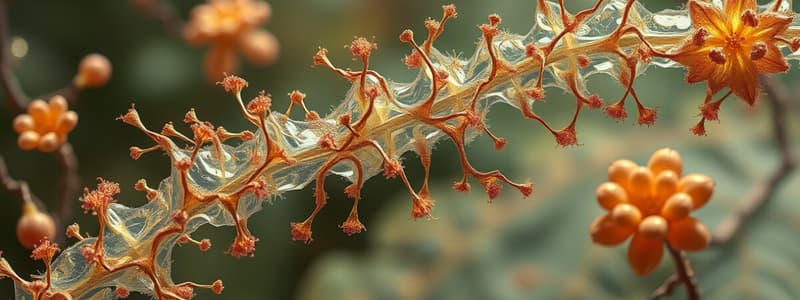Podcast
Questions and Answers
Which of the following best describes the difference between prokaryotes and eukaryotes?
Which of the following best describes the difference between prokaryotes and eukaryotes?
- Prokaryotes have a complete set of genes replicated and stored.
- Eukaryotes have membrane-bound organelles, while prokaryotes do not. (correct)
- Eukaryotes lack a plasma membrane.
- Prokaryotes are only found in extreme environments.
What is a primary characteristic of organisms classified as Archaea?
What is a primary characteristic of organisms classified as Archaea?
- They contain a complete set of genes that are not replicated.
- They are primarily found in decaying organic matter.
- They can be found in extreme environments. (correct)
- They are the most closely related to bacteria.
Where does protein synthesis occur in a cell?
Where does protein synthesis occur in a cell?
- Cytosol
- Ribosomes (correct)
- Plasma membrane
- Nucleus
Which domain of life includes all eukaryotic organisms?
Which domain of life includes all eukaryotic organisms?
What is the primary function of the plasma membrane?
What is the primary function of the plasma membrane?
What is biochemistry primarily concerned with?
What is biochemistry primarily concerned with?
Which of the following disciplines is NOT explicitly mentioned as a part of biochemistry?
Which of the following disciplines is NOT explicitly mentioned as a part of biochemistry?
What fundamental properties do all organisms share?
What fundamental properties do all organisms share?
How did early microorganisms utilize energy?
How did early microorganisms utilize energy?
What does the phrase 'We are stardust' imply about the elements in the human body?
What does the phrase 'We are stardust' imply about the elements in the human body?
What is the smallest unit of life as described in the document?
What is the smallest unit of life as described in the document?
In what way do multicellular organisms differ from single-celled organisms?
In what way do multicellular organisms differ from single-celled organisms?
Which statement is true about the composition of organisms?
Which statement is true about the composition of organisms?
What does the first law of thermodynamics state about energy in a system?
What does the first law of thermodynamics state about energy in a system?
What role do photoautotrophs play during photosynthesis?
What role do photoautotrophs play during photosynthesis?
How do chemotrophs obtain energy?
How do chemotrophs obtain energy?
Which statement best describes energy in an isolated system?
Which statement best describes energy in an isolated system?
What happens to energy when it is used by a system?
What happens to energy when it is used by a system?
What type of organism can survive in both the presence and absence of oxygen?
What type of organism can survive in both the presence and absence of oxygen?
Which of the following organelles is primarily involved in the detoxification of reactive oxygen species?
Which of the following organelles is primarily involved in the detoxification of reactive oxygen species?
What is the primary function of lysosomes within a cell?
What is the primary function of lysosomes within a cell?
In subcellular fractionation, what is the first step in the process?
In subcellular fractionation, what is the first step in the process?
During differential centrifugation, what determines where organelles accumulate in the tube?
During differential centrifugation, what determines where organelles accumulate in the tube?
Which organelle is notably membrane-bound and the site of oxidative phosphorylation?
Which organelle is notably membrane-bound and the site of oxidative phosphorylation?
What type of organism would die when exposed to oxygen?
What type of organism would die when exposed to oxygen?
What term describes the process of separating organelles from the cytosol?
What term describes the process of separating organelles from the cytosol?
What distinguishes Gram-positive bacteria from Gram-negative bacteria in terms of cell wall structure?
What distinguishes Gram-positive bacteria from Gram-negative bacteria in terms of cell wall structure?
Which of the following statements is true regarding Gram-negative bacteria?
Which of the following statements is true regarding Gram-negative bacteria?
What is the primary function of the peptidoglycan layer in bacteria?
What is the primary function of the peptidoglycan layer in bacteria?
Which type of bacteria would likely be more resistant to antibiotics?
Which type of bacteria would likely be more resistant to antibiotics?
What is the shape variety found in both Gram-positive and Gram-negative bacteria?
What is the shape variety found in both Gram-positive and Gram-negative bacteria?
In the context of bacteria, what do the terms aerobic and anaerobic refer to?
In the context of bacteria, what do the terms aerobic and anaerobic refer to?
What characteristic of Gram-negative bacteria contributes to their ability to resist the effects of certain antibiotics?
What characteristic of Gram-negative bacteria contributes to their ability to resist the effects of certain antibiotics?
Which of the following statements about the lipid content in Gram-positive and Gram-negative bacteria is correct?
Which of the following statements about the lipid content in Gram-positive and Gram-negative bacteria is correct?
Flashcards are hidden until you start studying
Study Notes
What is Biochemistry?
- Defined as the "Chemistry of the living cell."
- Aims to explain molecular structures, mechanisms, and chemical processes common to all life forms.
- Integrates principles from chemistry, biology, and physics to elucidate cellular functions.
- Involves various disciplines, including cell biology, genetics, immunology, microbiology, pharmacology, and physiology.
- Investigates how diverse biomolecules contribute to the unique properties of living organisms.
Origin of Life
- Life on Earth began roughly 4 billion years ago.
- Early microorganisms gained energy from chemical compounds and sunlight.
- These organisms created biomolecules from basic elements and compounds present on Earth.
- Nearly all elements in the human body originated from star processes.
Organism Types
- Microorganisms: Single-celled organisms with fundamental shared properties.
- Multicellular organisms: Composed of various cell types, exhibiting diverse shapes, sizes, and functions.
- Common structural features:
- Cytoplasm: Aqueous solution (cytosol).
- Plasma membrane: Hydrophobic lipid and protein barrier.
- Ribosomes: Sites of protein synthesis.
- Nucleus: The replication and storage site for all genetic information.
Domains of Life
- Life classified into three distinct domains based on evolutionary divergence:
- Bacteria: Found in soils, waters, and living/decaying organisms.
- Archaea: Reside in extreme environments like hot springs.
- Eukarya: Involves all eukaryotic organisms, more closely related to Archaea than Bacteria.
Bacterial Characteristics
-
Gram-Negative Bacteria:
- Cell wall: Double-layered and wavy.
- Thickness: 8-10 nm.
- Toxins present but require disturbance to release.
- Resist antibiotics due to outer membrane and lipopolysaccharide presence.
-
Gram-Positive Bacteria:
- Cell wall: Single-layer, smooth, thick (20-80 nm).
- Toxins readily released.
- More susceptible to antibiotics.
Oxygen Utilization in Organisms
- Aerobic: Utilize abundant oxygen for energy transfer.
- Anaerobic: Function in oxygen-free environments, using alternatives such as nitrate or sulfate.
- Obligate Anaerobes: Cannot survive in the presence of oxygen.
- Facultative Anaerobes: Can survive with or without oxygen.
Eukaryotic Cell Structures
- Comprised of membrane-bound organelles:
- Mitochondria: Primary site for energy extraction and ATP synthesis.
- Endoplasmic Reticulum and Golgi Complexes: Synthesize and process lipids and membrane proteins.
- Peroxisomes: Oxidize long-chain fatty acids and detoxify reactive oxygen species.
- Lysosomes: Contain digestive enzymes for degrading cellular debris.
Subcellular Fractionation
- Technique to separate organelles from cytosol:
- Cells ruptured through homogenization.
- High-speed centrifugation enables organelle separation based on size and density.
Energy Transformation
- First law of thermodynamics states energy in a closed system remains constant, but can change forms.
- Energy is not consumed; it transforms between different types as needed by living organisms.
Energy Sources in Organisms
- Photoautotrophs: Use sunlight during photosynthesis, splitting water to produce O2 and reducing CO2.
- Chemotrophs: Derive energy from oxidizing organic products of photosynthesis, transferring electrons to O2 to form water and CO2.
Studying That Suits You
Use AI to generate personalized quizzes and flashcards to suit your learning preferences.




